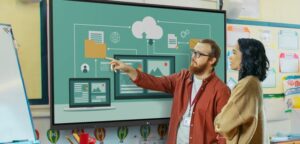
Engaging students in these strange times starts with enabling teachers to form connections with those in their classes, said CJ Reynolds during a recent Tech & Learning Virtual Roundtable hosted by Dr. Kecia Ray.
“If you can empower teachers you can then empower their students,” said Reynolds, a literature teacher at Boys’ Latin of Philadelphia and the creator of Real Rap With Reynolds.
Ray also spoke with Tony Riggs, an education market expert and CEO for NeedThese, and Michael Smith, head of global strategic alliances at Samsung, about strategies for creating new, engaging lesson plans for students regardless of their learning environment.
See the on-demand version here.
Key Takeaways
Talk Is Not Cheap
“We’re in this crazy space where kids can disappear so easily,” Reynolds said. “And it’s our job to connect to them and I think the easiest way to do that is to talk to kids, maybe in the first five minutes of class, or the last two to five minutes, or in their breakout rooms when they ask a question. Before jumping into whatever you’re learning that day, just ask questions like, ‘What video game is everyone playing? What do you watch on YouTube? Did anyone seen anything great on TV lately? Are you playing sports?’ Regular stuff that might give kids space to talk about what they’re interested in.”
After asking these questions, Reynolds advised teachers to really listen to the student responses. “This does two things: one, it shows kids that they matter, it shows them that you’re interested,” he said. “In doing that you’re making them the professionals in the moment. You’re making them the experts. So when they want to talk about some game or video or platform and what they’re into right now, they are now empowered because they know everything. And the other thing this does is it lets students who think that they’re invisible know that they are indeed visible.”
Converting Conversations
Reynolds uses that information he receives from candid conversations with his students to shape the classroom experience. “You take some of what you’ve learned, some of what kids have mentioned, and you turn it into lessons,” he said.
For example, Reynolds’ students are interested in hip hop, so he designed a class around the history of hip hop. The students learn about songwriting, poetry, and word choice as well as culture, and meet with graffiti artists and have rap battles with guest DJs participating.
Some years back he built vocabulary lessons around episodes of the “Jersey Shore” because that’s what his students were watching. More recently, he’s used examples from the uber-popular online video game Fortnite.
“Whether you are virtual, hybrid, or in person, we do projects in our class that allow students to share a bit of who they are,” Reynolds said.
For example, he had students read a short story then imagine it was a movie and make a mixtape of songs that would play over different scenes. “Maybe it’s the vibe of the song, maybe it’s the lyrics of the song,” Reynolds said. “You are creating this connection between what you want students to learn and what they need to learn and what they like. We’ve gone on to do this with stop-motion videos. We’ve made movie trailers for different stories that we read and articles that we’ve read. It is, again, just this simple opportunity to allow kids to marry who they are with what they’re learning. And I think that this creates an opportunity for student voice to really come about and also to create engagement.”
Engagement is Never Just About the Tech
Smith said when technology is working to help educators foster student engagement, no one thinks about it. “If you do technology properly, it goes away,” he said. “It physically disappears, and it allows something much more natural to occur in the classroom. So we’re keenly focused on one thing and one thing only, and that’s making tech seamless for teachers. It’s one thing to create a lesson plan when you’re in a classroom. It’s something entirely different, to try to make that translate over a PC and engage the student and bring them in. So that’s what I consider to be the experience we’re trying to reach.”
Riggs said that as educators have become more comfortable with technology the opportunities to utilize it have increased. “In the past, if a substitute teacher was called in, they’d come into the classroom and didn’t really have a handle on what was going on, they had to struggle through that, the students had to struggle through that, the administrators, and so on,” he said. “Those kinds of problems are going to start to be minimized.”
Today, even if a teacher can’t make their class in-person, they might be able to teach it remotely, and the same thing is true with students and attendance, Riggs says.
Funding For Tech Is Here But It’s All About Engagement
Having the right setup is key to connecting with students in hybrid or remote settings. “Before it was a monetary issue,” Riggs said. “That’s kind of gone away a little bit right now. There’s a lot of money for education.”
But he adds investments that schools make should be guided by recognizing the importance of teaching toward each individual student. “What do students like right now, they like clear audio, they like bright screens, they like interactivity,” Riggs said. “It goes back to teaching for the students. It’s finding a solution that’s engaging an instant gamification type of solution. It doesn’t need to be an hour-long conversation on one math problem. It can be just micro lessons and engaging. Our students are just quick quick quick, absorb, absorb, absorb, you know, input output.”
More from T&L: Lunch ‘n Learn roundtable recaps
What They’re Doing in Illinois
What They’re Doing in New York
What They’re Doing in California
Transitioning from Remote Learning to Blended Learning
Cybersecurity Planning for Next School Year
Finding & Funding the Best Tools for Any Learning Environment
How to Use Data to Prepare for the Upcoming School Year
Using Data to Prepare for Back to School
Online Filtering and Monitoring for Districts
Distance to Hybrid Learning: How to Drive Student Success
Best Sound Technology for Hybrid Classrooms and Remote Instruction
Linking Data Interoperability to Student Success
Social and Emotional Learning, Trauma, and This School Year
Ensuring Consistent Equitable Student Connectivity
Bracing for Whiplash: Helping Your Team Build Resilience for the Uncertainty to Come
Flipping Virtual Classrooms for More Impact
How Districts are Curbing Learning Loss During the Pandemic
Research-Informed Practices for Blended Learning
Addressing Learning Loss: Using Connected Assessments & LMS
Creating Secure and Equitable Learning Environments
Using Technology to Address Student Mental Health
Source: https://www.techlearning.com/news/engaging-students-in-any-environment
- &
- All
- around
- articles
- Artists
- audio
- BEST
- Bit
- breakout
- build
- ceo
- Connections
- Conversation
- conversations
- Creating
- creator
- Culture
- data
- day
- DID
- Education
- empower
- Environment
- experts
- First
- form
- Fortnite
- funding
- game
- Global
- great
- Guest
- head
- here
- Hip hop
- history
- How
- How To
- HTTPS
- Hybrid
- information
- Interoperability
- Investments
- IT
- Job
- Key
- kids
- LEARN
- learned
- learning
- literature
- Making
- Market
- math
- money
- monitoring
- movie
- online
- online video
- Opportunity
- Other
- PC
- planning
- platform
- Poetry
- professionals
- projects
- RE
- Rooms
- Safety
- Samsung
- School
- Schools
- seamless
- Share
- Short
- Simple
- So
- Space
- Sports
- start
- Stories
- Strategic
- Student
- teacher
- teachers
- Teaching
- tech
- Technology
- tv
- Video
- Videos
- Virtual
- Voice
- Watch
- WHO
- years
- youtube











